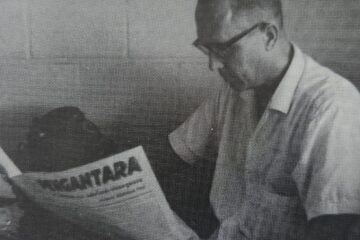As the Second World War engulfed Southeast Asia, the Netherlands East Indies (NEI) urgently sought military support. Isolated from its European homeland, which had been occupied by Nazi Germany since 1940, and facing imminent Japanese aggression, the colonial administration turned to the Allied powers for arms and logistical assistance. One of its key initiatives was the establishment of purchasing commissions abroad—first in the United States, and then, in January 1942, in Australia.
Establishing the purchasing mission
The Netherlands Purchasing Commission for Australia and New Zealand was formally established in late January 1942, just weeks before the fall of the NEI. Rear-Admiral Frederik Willem Coster arrived in Darwin on 27 January and continued to Melbourne, where the Commission was based. He was joined by Jan van Holst-Pellekaan and representatives of the Royal Netherlands Navy and the Royal Netherlands Indies Army. The Commission’s goal was to secure arms, ammunition, and supplies through Australia’s expanding wartime industries.
This mission complemented an earlier Dutch purchasing office in the United States, which had focused on acquiring aircraft and munitions, including long-range reconnaissance planes such as the Catalina flying boat. After the fall of the NEI in March 1942, both offices became crucial outposts of Dutch operations in exile, coordinating with Allied forces and acting as de facto diplomatic missions.
Logistical difficulties and mismatched expectations
Despite shared interests, the mission soon ran into difficulty. Australia’s industrial capacity was limited, and Britain and the United States received priority under the Lend-Lease system. Australia was only just beginning to scale up its own military production and remained deeply reliant on British approvals and logistical channels. Dutch requests for rifles, mortars, explosives, and vehicles were urgent and large, but Australian officials struggled to meet them. Some ammunition was supplied, and thousands of rifles were rebored for Dutch use, but many orders were only partially filled or delayed beyond usefulness.
To support these purchases, the Dutch brought with them significant financial assets, including gold reserves evacuated from Java in early 1942. This effort—known as Operation Accountant—ensured that the exiled NEI administration could pay for military equipment, logistical support, and salaries from within Australia.
As Jack Ford notes in Allies in a Bind, this created significant diplomatic friction. Dutch officials, frustrated by delays, saw the responses as inadequate given their own prior commitment to defending the Brits in Malaya and Singapore. Australian officials, for their part, viewed the Dutch requests as overambitious given Australia’s own needs. These misaligned expectations and miscommunications led to mutual irritation and a sense of being undervalued on both sides.
R. W. A. van den Berg, in Unchained Interests, contextualises this within the broader challenges of coalition warfare. The Dutch were a relatively small Allied partner, lacking the political clout of the major powers. The NEI was not prioritised in strategic planning, and the Netherlands government-in-exile had little leverage to alter Allied decision-making. The Dutch were forced to rely on informal channels, which were often slow and bureaucratically constrained.
Australia’s bureaucracy complex and unprepared
Dutch purchasing efforts were repeatedly hampered by complex and often opaque Australian administrative processes. Requests for military equipment were passed between multiple departments, including Defence, Munitions, Civil Aviation, and External Affairs. In several cases, Dutch officials believed they had secured access to key aircraft types—such as Bostons, Catalinas, or Lodestars—only to be told the aircraft were under American control and thus unavailable. Negotiations were further complicated by shifting US–Australian supply agreements.
Jack Ford highlights that these obstacles, though often logistical in nature, were interpreted by many Dutch officials as a lack of political will. Some Dutch officers expressed open resentment, believing Australia failed to appreciate the sacrifices the NEI had already made in Allied defence. Australian counterparts, meanwhile, grew tired of what they saw as Dutch impatience and diplomatic inflexibility.
The racial barrier: Indo evacuees and the White Australia Policy
Compounding these difficulties were cultural and political differences. Dutch civilians arriving in Australia included many Indos—people of Dutch or mixed Indonesian descent—who encountered suspicion and even discrimination under Australia’s White Australia Policy. Dutch authorities considered Indos part of the European population of the Indies, but Australian immigration officials often did not agree. Some evacuees were held up in ports or denied access to housing and services.
The White Australia Policy also created deeper political tensions. While segments of Australian society—especially trade unions and progressive groups—were sympathetic to Indonesian independence, the official stance remained cautious. Australia’s racial policies made it difficult for the government to fully endorse any multicultural or independent future for Indonesia. This conflicted with Dutch reformist ideas, particularly those advocated by figures like Hubertus van Mook, who was already envisioning a postwar federal structure that included autonomy for Indonesians.
Van Mook and other Dutch officials attempted to shield their people from discriminatory treatment and worked to secure recognition of the Dutch government-in-exile’s legitimacy. But contradictions between Dutch visions of postwar reform and Australian internal policies made true alignment difficult. The relationship between the two countries was shaped as much by shared vulnerability as by shared ideals.
Despite obstacles collaboration and cooperation was forged
Despite all of this, the Dutch purchasing mission in Australia played an important symbolic and diplomatic role. It marked the beginning of more permanent Dutch–Australian political contact and highlighted Australia’s shift from a British outpost to an increasingly independent regional actor. It also underscored the challenges smaller Allied nations faced in having their voices heard, and the lasting tensions that could emerge when logistical needs collided with political limitations. In the mean the Dutch were provided with access to ports and airports around the country and were supported by the local authorities and staff at these facilities.
This article is part of a six-part series on Dutch–Australian wartime cooperation. For related perspectives, see:
- Between secrecy and survival: Australia’s frustration with Dutch neutrality on the eve of war.
- Divided in exile: tensions between Batavia and London in the Dutch war effort.
- Reform or restoration? Political tensions over the future of the Netherlands East Indies during wartime exile.
- Wartime reform and Indonesian voices: Dutch–Indonesian political tensions in exile.
- From indifference to diplomacy: how the war transformed Dutch–Australian foreign relations
- A Dutch military and civil inventory in Australia – March 1942 snapshot
References:
Jack Ford, Allies in a Bind: Australia and the Netherlands East Indies in the Second World War, CQU Press, 2001
R. W. A. van den Berg, Unchained Interests, Netherlands Staff College Monograph, 2021

